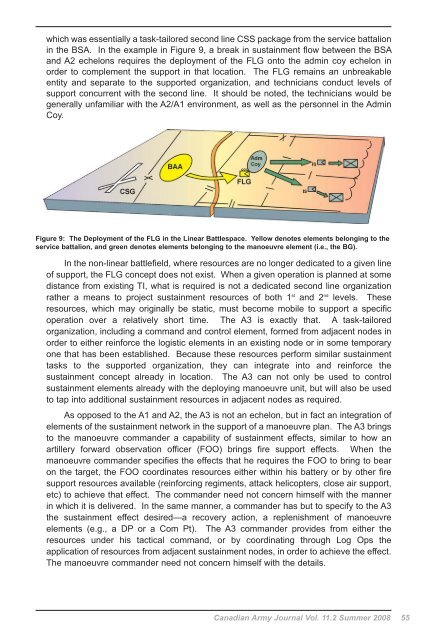Practical Sustainment Concepts for the Non-Linear Battlespace
Practical Sustainment Concepts for the Non-Linear Battlespace
Practical Sustainment Concepts for the Non-Linear Battlespace
Create successful ePaper yourself
Turn your PDF publications into a flip-book with our unique Google optimized e-Paper software.
which was essentially a task-tailored second line CSS package from <strong>the</strong> service battalion<br />
in <strong>the</strong> BSA. In <strong>the</strong> example in Figure 9, a break in sustainment flow between <strong>the</strong> BSA<br />
and A2 echelons requires <strong>the</strong> deployment of <strong>the</strong> FLG onto <strong>the</strong> admin coy echelon in<br />
order to complement <strong>the</strong> support in that location. The FLG remains an unbreakable<br />
entity and separate to <strong>the</strong> supported organization, and technicians conduct levels of<br />
support concurrent with <strong>the</strong> second line. It should be noted, <strong>the</strong> technicians would be<br />
generally unfamiliar with <strong>the</strong> A2/A1 environment, as well as <strong>the</strong> personnel in <strong>the</strong> Admin<br />
Coy.<br />
Figure 9: The Deployment of <strong>the</strong> FLG in <strong>the</strong> <strong>Linear</strong> <strong>Battlespace</strong>. Yellow denotes elements belonging to <strong>the</strong><br />
service battalion, and green denotes elements belonging to <strong>the</strong> manoeuvre element (i.e., <strong>the</strong> BG).<br />
In <strong>the</strong> non-linear battlefield, where resources are no longer dedicated to a given line<br />
of support, <strong>the</strong> FLG concept does not exist. When a given operation is planned at some<br />
distance from existing TI, what is required is not a dedicated second line organization<br />
ra<strong>the</strong>r a means to project sustainment resources of both 1 st and 2 nd levels. These<br />
resources, which may originally be static, must become mobile to support a specific<br />
operation over a relatively short time. The A3 is exactly that. A task-tailored<br />
organization, including a command and control element, <strong>for</strong>med from adjacent nodes in<br />
order to ei<strong>the</strong>r rein<strong>for</strong>ce <strong>the</strong> logistic elements in an existing node or in some temporary<br />
one that has been established. Because <strong>the</strong>se resources per<strong>for</strong>m similar sustainment<br />
tasks to <strong>the</strong> supported organization, <strong>the</strong>y can integrate into and rein<strong>for</strong>ce <strong>the</strong><br />
sustainment concept already in location. The A3 can not only be used to control<br />
sustainment elements already with <strong>the</strong> deploying manoeuvre unit, but will also be used<br />
to tap into additional sustainment resources in adjacent nodes as required.<br />
As opposed to <strong>the</strong> A1 and A2, <strong>the</strong> A3 is not an echelon, but in fact an integration of<br />
elements of <strong>the</strong> sustainment network in <strong>the</strong> support of a manoeuvre plan. The A3 brings<br />
to <strong>the</strong> manoeuvre commander a capability of sustainment effects, similar to how an<br />
artillery <strong>for</strong>ward observation officer (FOO) brings fire support effects. When <strong>the</strong><br />
manoeuvre commander specifies <strong>the</strong> effects that he requires <strong>the</strong> FOO to bring to bear<br />
on <strong>the</strong> target, <strong>the</strong> FOO coordinates resources ei<strong>the</strong>r within his battery or by o<strong>the</strong>r fire<br />
support resources available (rein<strong>for</strong>cing regiments, attack helicopters, close air support,<br />
etc) to achieve that effect. The commander need not concern himself with <strong>the</strong> manner<br />
in which it is delivered. In <strong>the</strong> same manner, a commander has but to specify to <strong>the</strong> A3<br />
<strong>the</strong> sustainment effect desired—a recovery action, a replenishment of manoeuvre<br />
elements (e.g., a DP or a Com Pt). The A3 commander provides from ei<strong>the</strong>r <strong>the</strong><br />
resources under his tactical command, or by coordinating through Log Ops <strong>the</strong><br />
application of resources from adjacent sustainment nodes, in order to achieve <strong>the</strong> effect.<br />
The manoeuvre commander need not concern himself with <strong>the</strong> details.<br />
Canadian Army Journal Vol. 11.2 Summer 2008 55







![La modularite dans l'Armee de terre canadienne [pdf 1.6 MB]](https://img.yumpu.com/17197737/1/188x260/la-modularite-dans-larmee-de-terre-canadienne-pdf-16-mb.jpg?quality=85)









